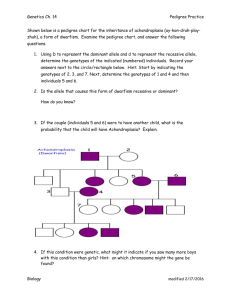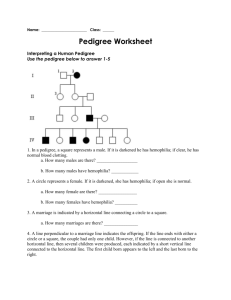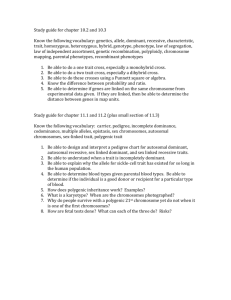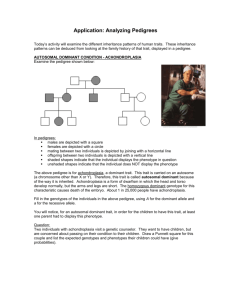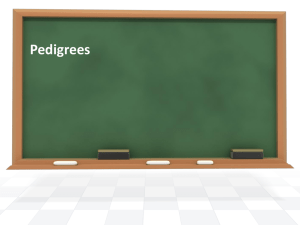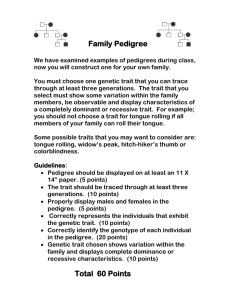Pedigree Worksheet
advertisement
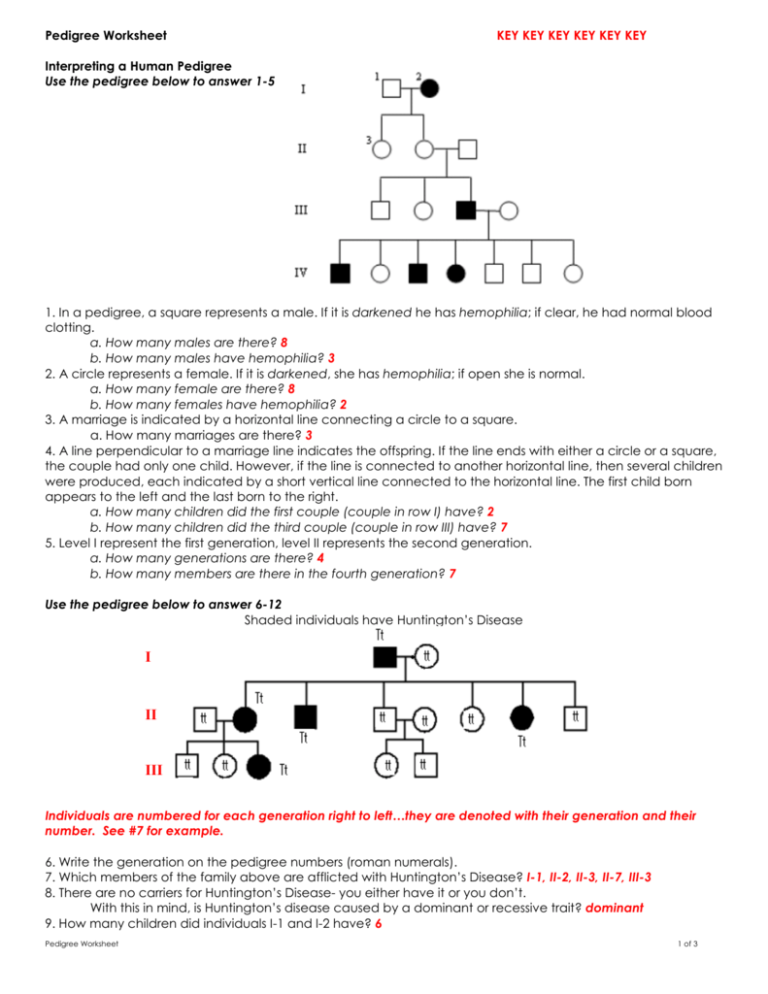
Pedigree Worksheet KEY KEY KEY KEY KEY KEY Interpreting a Human Pedigree Use the pedigree below to answer 1-5 1. In a pedigree, a square represents a male. If it is darkened he has hemophilia; if clear, he had normal blood clotting. a. How many males are there? 8 b. How many males have hemophilia? 3 2. A circle represents a female. If it is darkened, she has hemophilia; if open she is normal. a. How many female are there? 8 b. How many females have hemophilia? 2 3. A marriage is indicated by a horizontal line connecting a circle to a square. a. How many marriages are there? 3 4. A line perpendicular to a marriage line indicates the offspring. If the line ends with either a circle or a square, the couple had only one child. However, if the line is connected to another horizontal line, then several children were produced, each indicated by a short vertical line connected to the horizontal line. The first child born appears to the left and the last born to the right. a. How many children did the first couple (couple in row I) have? 2 b. How many children did the third couple (couple in row III) have? 7 5. Level I represent the first generation, level II represents the second generation. a. How many generations are there? 4 b. How many members are there in the fourth generation? 7 Use the pedigree below to answer 6-12 Shaded individuals have Huntington’s Disease I II III Individuals are numbered for each generation right to left…they are denoted with their generation and their number. See #7 for example. 6. Write the generation on the pedigree numbers (roman numerals). 7. Which members of the family above are afflicted with Huntington’s Disease? I-1, II-2, II-3, II-7, III-3 8. There are no carriers for Huntington’s Disease- you either have it or you don’t. With this in mind, is Huntington’s disease caused by a dominant or recessive trait? dominant 9. How many children did individuals I-1 and I-2 have? 6 Pedigree Worksheet 1 of 3 10. How many girls did II-1 and II-2 have? 3 How many have Huntington’s Disease? 2 11. How is individual III-2 and II-4 related? niece-uncle I-2 and III-5? grandma-grandson 12. Write the genotypes of each individual on the pedigree. Use the Pedigree below to answer 13-18 I II III IV 13. Write the generation on the pedigree numbers (roman numerals). The pedigree to the above shows the passing on of Hitchhiker’s Thumb in a family. Is this trait dominant or recessive? recessive 14. How do you know? Because parents III-4 and III-5 had to have kids IV-2 and IV-4 15. How are individuals III-1 and III-2 related? mating 16. Name 2 individuals that have hitchhiker’s thumb. IV-2 and IV-4 17. Name 2 individuals that were carriers of hitchhiker’s thumb. III-4 and III-5 18. Write the genotypes for each individual on the pedigree. Determining Inheritance Patterns 19. When working through a pedigree, the first thing you need to do is figure out which characteristic is dominant – the shaded one or the un-shaded one. Then you need to choose a letter (let’s use A) and begin assigning genotypes. Remember that recessive individuals are always homozygous, so assign their genotypes first. Then go back and look at all of the dominant individuals. For some, you will only be able to determine one allele of the genotype, so just write the one capital allele followed by a question mark (A?). a. Which characteristic is dominant? Black b. Which characteristic is recessive? White c. Determine the genotypes of all individuals. You will have three “A?”. Write your Genotypes beneath each individual. Pedigree Worksheet 2 of 3 20. Is the trait dominant or recessive? recessive Write the genotype for each individual (use the letter A) 21. Is the trait dominant or recessive? dominant Write the genotype for each individual (use the letter A) Making Conclusions 22. If a child has an autosomal dominant trait, what can you say about the parents? At least one parent has the trait 23. If two parents have an autosomal dominant trait, what can you say about their children? If one of the parents is homozygous then all the children will have it. If both parents are heterozygous, then there is a 75% chance that they will have the trait. 24. If two parents have an autosomal recessive trait, what can you say about their children? All their children will have the trait 25. If two parents do not have an autosomal recessive trait, what can you say about their children? If one of the parents is homozygous dominant then none of the children will have it. If both parents are heterozygous, then there is a 25% chance that they will have the trait. 26. Can autosomal recessive traits skip generations? Yes, example – heterozygous parents can make a homozygous recessive child Pedigree Worksheet 3 of 3



